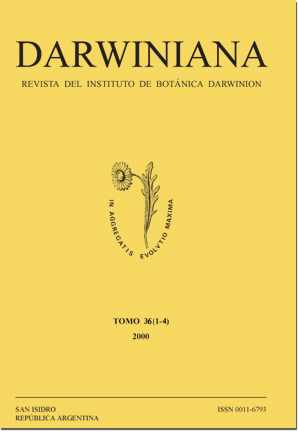Some aspects of the reproductive biology of Tropaeolum pentaphyllum (Tropaeolaceae)
DOI:
https://doi.org/10.14522/darwiniana.2014.361-4.320Keywords:
Ornithophily, Tropaeolaceae, Nectary anatomy, Nectar, Reproductive biology, PollinationAbstract
The spur anatomy and some aspects of the floral biology of the perennial herb Tropaeolum pentaphyllum Lam. were studied. The hermaphrodite protandrous flowers are typically ornitophilous. They have a red spur which produces abundant nectar secreted through modified stomata. Nectar concentration is variable (27-63% sugars), and its production is greater in the staminate phase than in the pistillate one. Tropaeolum pentaphyllum seems to be a principally xenogamous spedes. Main pollinators are hummingbirds, but bee pollination cannot be discarded. The low rate of fruit production in isolated branches might have arisen through autogamy, but small arthropods carrying pollen grains on their bodies were occasionally observed on those branches, which may indicate that sorne cross-pollination is also present. The lack of fruit production in isolated and emasculated flowers indicates that there is no apomixis.Downloads
Published
31-12-2011
How to Cite
Fabbri, L. T., & Valla, J. J. (2011). Some aspects of the reproductive biology of Tropaeolum pentaphyllum (Tropaeolaceae). Darwiniana, Nueva Serie, 36(1-4), 51–58. https://doi.org/10.14522/darwiniana.2014.361-4.320
Issue
Section
Reproductive Biology
License

Starting on 2012, Darwiniana Nueva Serie uses Licencia Creative Commons Atribución-NoComercial 2.5 Argentina .






